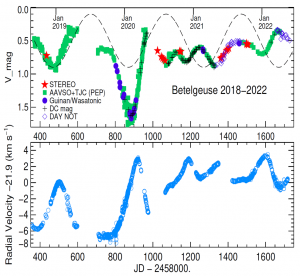SESDA Team Investigates Betelgeuse Surface Mass Ejection
June 14, 2022

The Astrophysical Journal has accepted for publication the paper, “The Great Dimming of Betelgeuse: A Surface Mass Ejection (SME) and its Consequences” by Dupree et al. The paper analyzed special data taken by the SESDA team using the SECCHI/HI-2 telescope on STEREO Ahead, taking advantage of the spacecraft’s unique position, and rolling by 180°, to observe Betelgeuse when it could not easily be observed from Earth. The paper concludes that a substantial surface mass ejection (SME) occurred and moved out through the extended firmament of the supergiant. Following the SME, Betelgeuse was left with a cooler average photosphere, an unusual short photometric oscillation, reduced velocity excursions, and the disappearance of the ~400-day pulsation in the optical and radial velocity for more than two years following the Great Dimming. The first indication that Betelgeuse was affected by the SME was provided by the SECCHI observations.
Comments are closed.
-
Article Details:
Posted on: Tuesday, June 14th, 2022
Posted in: News, SESDA News
Subscribe: RSS 2.0
Comments: No Responses -
Recent News:
